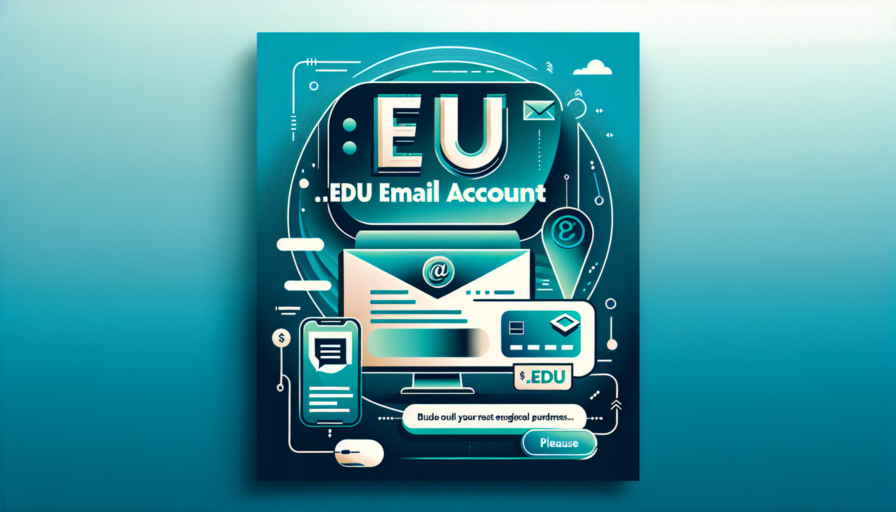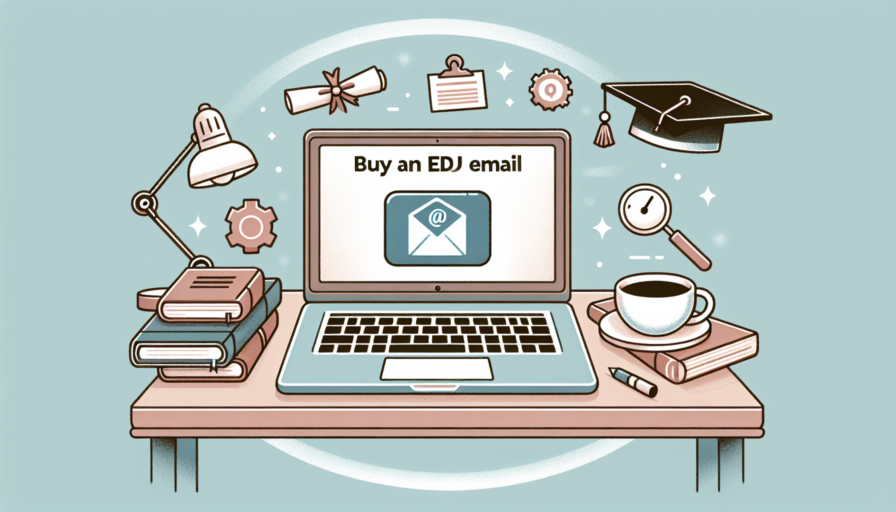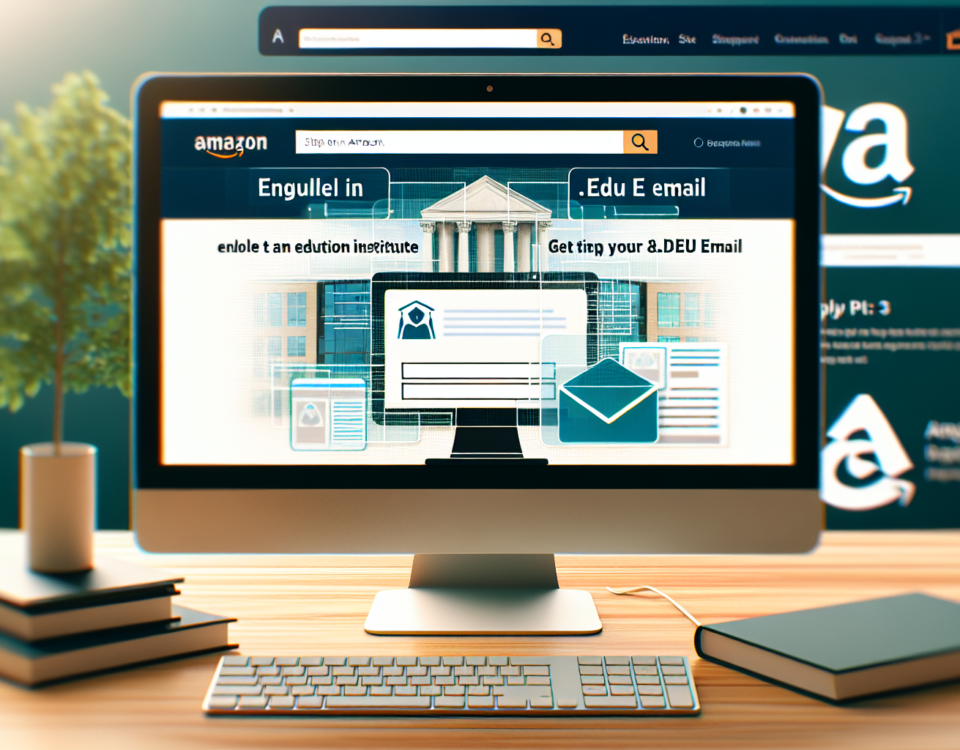
Unlocking Academic Privileges: How to Obtain an Email Address Ending in .edu
February 15, 2024
How to Get an EDU Email: Ultimate Guide for Students and Educators
February 15, 2024What is an EDU Mail Account and How Does it Enhance Google Drive?
An EDU mail account is typically an email address that is provided by educational institutions, such as universities and colleges, to their students, faculty, and sometimes alumni. This email address has an “.edu” extension, which signifies its educational origin. These email accounts are not only important for institutional communication and access to academic resources, but they also bring a plethora of benefits, particularly when linked to various services from tech giants like Google.
One of the significant advantages associated with an EDU mail account is the enhanced storage capacity on services like Google Drive. Google Drive is a cloud-based storage and synchronization service that enables users to store files online, share them, and have access to them from any internet-connected device. When you sign up for Google Drive with a regular account, you are given a standard amount of free storage. However, educational institutions that partner with Google typically provide access to Google Workspace for Education, which can include significantly increased storage capacity – sometimes even unlimited – on Google Drive for accounts registered with an EDU email.
Such an increase in storage space allows students and educators to work with more extensive collections of documents, multimedia files, and large datasets without worrying about running out of space. Harmonizing the collaboration and learning environment, an EDU account can serve as a digital backbone for academic projects, research, and the dissemination of educational materials. Moreover, the reliance on Google Drive with an EDU account helps ensure that these resources are secured under institutional oversight, featuring enhanced security protocols that are often part of educational agreements with Google.
Additionally, Google Drive integrated with an EDU mail account often grants access to various premium features and extended capabilities that are not available with standard accounts. This can include more powerful sharing options, advanced search and organization tools, and the priority for early access to new features rolled out by Google. The symbiotic relationship between an EDU mail account and Google Drive is a testament to how the digitalization of education is evolving, providing students and educators with an edge in accessibility, collaboration, and data management.
How to Access Unlimited Google Drive Storage with Your EDU Email
Google Drive offers one of the most generous cloud storage solutions available, especially for students and educators. Individuals with an EDU email address are often granted access to vastly expanded storage capacity, sometimes even with no upper limit, at no additional cost. This can be a game-changer for those handling large research projects, video lectures, and extensive libraries of educational materials. It allows for seamless collaboration and backup of important documents and multimedia files without worrying about running out of space.
The process to unlock this unlimited storage with your EDU email typically starts with verifying your educational status. This is because Google partners with educational institutions to offer expanded services for their students and staff. Once verified, users can access Google Drive through their educational portal or directly through the Google Drive website. It’s essential to understand the terms of service associated with your educational account, as they might differ from personal Google Drive accounts.
Additionally, the unlimited storage feature of Google Drive for education accounts is not just about individual use. It extends to collaborative efforts as well. With an EDU email, you can share folders and files with classmates or colleagues, making group assignments and projects much more manageable. Google’s shared drives allow teams to store, search, and access files anywhere, from any device. Monitoring and managing file permissions also ensures that only the right people have access to sensitive information, enhancing collaboration without compromising security.
For students or faculty members just starting out with their EDU Google Drive accounts, it’s worth exploring the additional tools and features Google offers. These range from shared calendars to productivity apps like Google Docs and Sheets that integrate directly with Drive storage. Learning how to leverage these tools in tandem with the vast storage capability can greatly augment a person’s educational experience and productivity.
The Collaboration Power of Google Drive for Students and Educators
At the core of any educational experience is the collaboration between students and educators. In today’s digital landscape, Google Drive stands out as an instrumental tool in facilitating this essential element. This powerful platform’s capabilities extend well beyond mere file storage; it provides a dynamic environment where both students and educators can work together in real time, irrespective of their physical locations. Embracing Google Drive in educational settings can significantly reshape how assignments are distributed, completed, and reviewed.
Effortless Sharing and Real-Time Communication
One of Google Drive’s standout features is its seamless sharing functionality. With just a few clicks, educators can share materials with an entire class, allowing instant access to documents, slides, and spreadsheets. Students, in turn, can submit their work directly through Drive, as well as collaboratively engage in group projects. Real-time communication is facilitated through the ability to leave comments, suggest edits, and even chat within documents. This immediacy of feedback and interaction serves to streamline the educational process and encourages an ongoing dialogue that transcends the traditional classroom boundaries.
Interactive Classrooms with Shared Workspaces
Google Drive’s shared workspaces act as a virtual extension of the physical classroom. These areas can be customized and structured by educators to mirror the subject matter and intended learning outcomes. Within these workspaces, students can work in tandem on collective assignments, cultivate ideas using shared resources, and foster a sense of community. Educators can oversee these interactions, providing real-time assistance and guidance, thereby enhancing the overall learning experience. The collaborative power of these shared workspaces stands as a testament to the adaptability and scalability of Google Drive in educational environments.
Enhanced Project Management Capabilities
Efficient project management is crucial in educational settings, and Google Drive excels in this domain. The intuitive interface allows educators to create folders for different classes or subjects, monitor project progress, and set due dates. Students benefit from Google Drive by being able to organize their work, set personal reminders, and collaborate with peers on joint projects with ease. Automated versioning of documents ensures that the evolution of each project is recorded, allowing students and educators alike to track changes and revert to earlier versions if necessary.
Maximizing Academic Productivity: Advanced Google Drive Features for Education
In today’s academic landscape, Google Drive stands out as an instrumental tool for students, teachers, and researchers alike. To truly maximize academic productivity, it is essential to dive into the advanced features of Google Drive that are tailored to enhance your educational experience. From seamless collaboration to powerful organizational capabilities, these features foster an environment where educational resources and projects flourish.
One such advanced feature is the use of Google Drive’s priority page, which intuitively surfaces your most important files. Backed by Google’s AI, this page helps streamline your work by suggesting which documents to prioritize based on your activity. This is especially beneficial in educational settings where countless documents and assignments accumulate over time. By employing the Priority page and accompanying Workspaces, educators and students can organize coursework and research material into easily accessible hubs, minimizing the time spent searching for files.
Enhanced Collaboration Tools
Further enhancing academic productivity, Google Drive’s robust collaboration tools empower users to work together in real time. With features like suggesting mode in Google Docs and commenting abilities across the platform, multiple users can review, edit, and provide feedback on a single file simultaneously. This is particularly advantageous for group projects, peer reviews, or when working on shared research initiatives. Gone are the days of sending multiple versions of a document back and forth – with Google Drive, all collaborators can contribute to a unified version, fostering a dynamic and interactive learning environment.
Streamlined Integration with Educational Tools
Moreover, Google Drive’s advanced features reach beyond its own ecosystem by offering seamless integration with an array of third-party applications and educational tools. For example, Google Drive hooks into widely used learning management systems (LMS) such as Canvas or Blackboard, allowing users to submit assignments and collaborate on projects directly through the LMS interface. This integration is fundamental in creating a central hub for all educational activities and resources, ensuring that the transition between different tools is smooth and that the academic workflow is unified and efficient.
Securing Your Educational Data: Tips for EDU Email Users on Google Drive
When it comes to securing your educational data on Google Drive, there are several proactive steps that EDU email users should take to protect their sensitive information. Google Drive’s platform, widely used in the educational sector for storing and sharing documents, presentations, and spreadsheets, may contain personally identifiable information, student records, or research data. Ensuring this data remains confidential and safeguarded against unauthorized access is of paramount importance.
Use Strong and Unique Passwords
To begin with, strong password hygiene is fundamental. As an EDU email user, creating a unique and complex password for your Google account can significantly reduce the likelihood of unauthorized access. It’s advisable to use a combination of uppercase and lowercase letters, numbers, and special characters in your password. Moreover, refrain from using predictable patterns or easily guessable details, such as your name or birthdate. Regularly updating your passwords and not repeating them across multiple accounts can further reinforce your data security.
Enable Two-Factor Authentication
Another vital layer of security is two-factor authentication (2FA). This requires a second form of identification beyond just your password, which means even if your password were to be compromised, an attacker would be less likely to gain access to your account. Google provides various 2FA methods, such as SMS verification codes, authentication apps, or even physical security keys. By enabling this feature, you can significantly lessen the risk of unauthorized access to your educational documents and information on Google Drive.
Manage Shared Files and Permissions Wisely
The collaborative nature of Google Drive means that file sharing and real-time collaboration are effortless. However, this ease of sharing can lead to accidentally granting file access to the wrong people or leaving files open to wider audiences than necessary. EDU email users must stay vigilant and frequently review sharing settings. Consider setting shared files to “View Only” when edit permissions are unnecessary, and routinely audit your shared files to ensure that access is still warranted. Removing individuals from the access list when their involvement is no longer needed can prevent unwanted data exposure.
By adopting these security measures, EDU email users can significantly bolster the defense of their educational data within Google Drive. Regularly reviewing and updating security practices will ensure that sensitive educational materials remain protected in an increasingly digital world.








